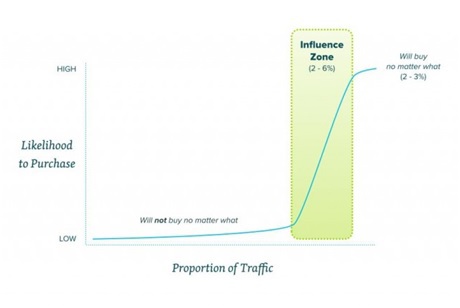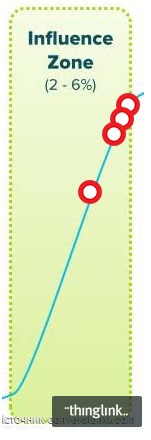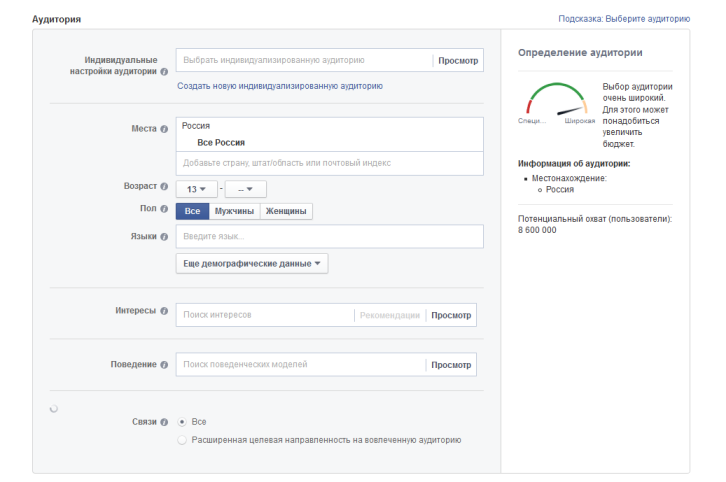How to convince visitors of your site to buy a product using competitors? Part 1

This time we want to share the first part of Tommy Walker's material on how to deal with the prejudices of potential customers and persuade the doubting visitors of your site to purchase, using information about competitors.
I often hear statements about different brands around me:
- I use Tide powder! I washed them the last 10 years. I will wash only tide until death!
')
- Oh, God, do what you want, but in the clothes from Gap I will be a real laughing stock!
All these people have already established ideas about the brand, which cannot be changed through advertising, advice from friends, and marketing. Or is it possible?
According to the customer distribution schedule, there are:
- a large reservoir of people who would not buy from you,
- those who will always buy everything from you (2-3% of traffic),
- layer of people who are at the stage of selection (zone of influence, 2-6% of traffic).

Each of us has visitors who will never, for anything, under any circumstances, buy (competitors, onlookers looking in the windows of shops, people conducting research, etc.).
Of course, you should try to minimize the number of inactive customers who visit the site, working with traffic, choosing the right channels and using more advanced settings for advertising campaigns, such as negative keywords and geo-targeting. You can also stop spending money and make efforts to attract non-convertible traffic ... but this also does not solve the problem.
Why users do not buy: the psychological side of the question
Comparing the above-mentioned graph with the opinions heard, I came to the conclusion that it is not pricing or design that influences the user's desire to purchase goods.
Of course, it is easy to say that quite a bit to correct the schedule, tell an interesting story, improve the call to action or microcopy, and this will improve the profits from your site.
It may, of course, improve, but this will happen only in the upper curve within the zone of influence.

But what about the bottom of the curve? With this will be more difficult.
There are users who roam on different sites, doing the so-called “comparison”, trying to find convenient offers that are not very profitable for you, such as a flexible return policy, customer reviews and free shipping. For example, 61% of buyers are ready to throw a basket if they are not offered free shipping.
Let's try to work with the lower part of the curve.

Analyzing the prejudices of your competitors
In order to incline potential customers from the bottom of the curve, you need to study the market and competitors. This knowledge is very important, because often your customers and customers of competitors believe that you lack some important function or key advantage, while you have it all.
For example, I had a client who sold software for a law firm. After analyzing analog solutions and substitute solutions, I found that he had only 3-4 direct competitors and a small group of competitors on the periphery who used similar solutions (such as calendars and management contacts), but they were not directly involved in legal practice.
During the research of competitors, their clients and the market as a whole, I came to the conclusion that most law firms do not even consider the option of purchasing software if it does not meet the following characteristics:
1. It has already been used by lawyers.
2. The software company had experience working with real lawyers who can vouch for it, if necessary.
At a deeper level, this is explained by the fact that they hardly got rid of their penchant for maintaining the status quo, when they felt comfortable only if everything was as it was.
I also learned that those who chose the decision of competitors did not believe that my client met all their requirements, which means that he could not overcome the main prejudice that stops users at the time of making a purchase decision.
They did not know that my client had a much wider user base than competitors (more than 250,000 users) and that his experience was more than 30 years.
As a result, they decided not to focus on the number of 250,000 clients and use photos of fake users to "make an impression." In the end, information about their client base and work experience looked like this:

However, it seems that one of their main competitors conducted similar research around the same time, because eventually they changed the design of the site, which began to look like this:

As some studies show , when information is displayed on a landing page or in a title, it seems to users that it is more important. That is, if you say that a product saves 8 hours of time, then this is more important than its design or price.
There is also a crowd effect that we talked about earlier when people prefer to surround themselves with personalities who look, think and act the same way they do. At the same time, they tend to be wary of people from other circles.
Therefore, fake photos from the drains will not cause the effect of the crowd, which the company needs so much to make a potential client real.
Analysis of your competitors
Despite the fact that you do not have access to the database of competitors' customers, there are several methods that you can use to find out what your competitors are thinking about.
Method number 1. Conduct a direct survey using Facebook Ads
The main advantage of the social network Facebook, in which more than 1.2 billion users are registered, is the fact that many people create separate pages specifically to like the companies with which they cooperate. This is to create closer relationships with partners.
Luckily for you, likes really create these links as one of the target parameters for Facebook Ad.

By clicking on the “audience” button on your Facebook page , you can get a little more information.

Now, depending on the characteristics of your competitor, and how secretive the client will be, you can improve your partnership with a third party to use the results.
For example, if MailChimp would like to interview the AWeber customers, they would most likely have achieved a better response with a partner like the eMail Institute than if they were acting alone.
Create a survey for customers of your competitors
During the development of the survey you need to overcome your own illusory superiority - the confidence that you are much better than your competitors. Then you can easily understand why users prefer a competitor rather than you.
Ask questions like:
1. What attracts you to [the name of a competitor’s company]?
2. How do you benefit them [product / service]?
3. How would you rate their service?
4. How quickly do they respond to requests?
5. How do you feel about [your company name]?
6. What should we do for you to choose us?
... along with other descriptions of customer requirements, you can determine for yourself the optimal types of questions that will help you understand customer needs, divide users into several groups, and understand how a competitor's customer perceives his activities.
This document, published at MIT , teaches you to intelligently use existing methodologies to create an effective consumer survey to learn more about how to increase your customer numbers. It is very important to structure the survey results correctly.
For example, based on a survey of cinema visitors, seventeen “tactical” needs were identified (cleanliness in the cinema hall, comfortable chairs, high-quality sound and good visibility, a rich selection of films, etc.). In turn, these needs were divided into six “strategic” categories - a wealth of choices, impressions of watching a movie, a cinema building, food and beverages, a cinema hall, a cinema location.
From the point of view of competition, your goals should be not only an understanding of the weak points of competitors, but also the role that you play for their clients.
In some cases, they are simply unaware of your existence, in others their opinion of you is wrong or they are simply not familiar with your brand.
Source: http://conversionxl.com/customers-will-never-buy/?hvid=4L08rO
Source: https://habr.com/ru/post/231537/
All Articles